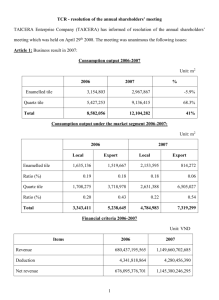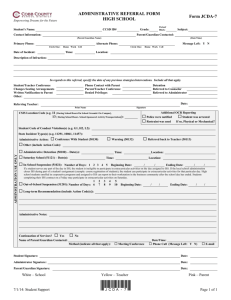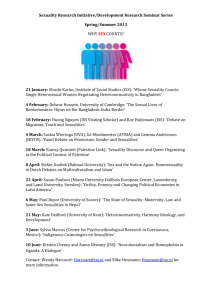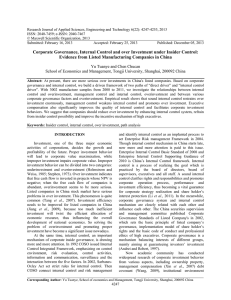Econ 234C — Corporate Finance Lecture 4: Internal Investment (III) Ulrike Malmendier
advertisement
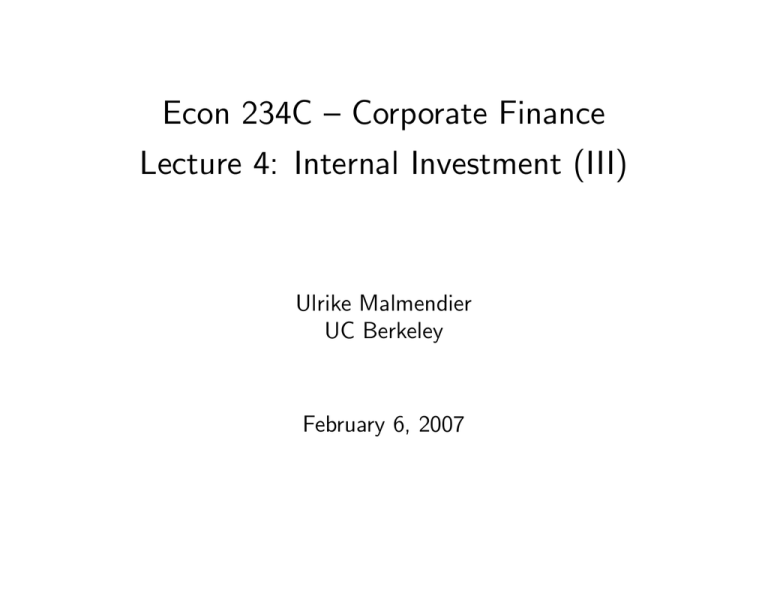
Econ 234C — Corporate Finance
Lecture 4: Internal Investment (III)
Ulrike Malmendier
UC Berkeley
February 6, 2007
Outline
1. Financial Economics: Update on Seminar; Student Seminar; Class Email
List and your background information
2. Internal Investment (II, continued): Asymmetric Information
3. Internal Investment (III): Moral Hazard
4. Internal Investment (IV): Overconfidence
1
Financial Economics
1.1 Update on the Financial Economics Seminar:
http://emlab.berkeley.edu/users/webfac/malmendier/e235_sp07/e235.shtml
• Idea of the seminar this semester/next semester
• Discussion of individual talks
1.2 Prospects for a student seminar / weekly meeting:
• Haas and ARE?
• Time & day?
1.3 Homeworks: If you email a file, please make your name part of the filename!
And, whether you email or hand it in: please put your name on the homework.
1.4 Student information sheets ...
2
Internal Investment (II, continued)
A Follow-Up to the introduction of I/CF sensitivity:
Big underlying question: Are investment decisions (in corporations) optimal?
The vast majority of the literature has restricted itself to the analysis of I/CF
sensitivity. But any sensitivity to factors that, in a perfect frictionless
capital market, should not affect investment would be equally interesting.
A recent example: Thomas Chaney, David Sraer, and David Thesmar:
“How Do Firms React to Balance Sheet Shocks?”
(http://www.crest.fr/pageperso/david.sraer/collateral02.pdf)
• Variation across firms in land holdings
• Variation across states in real-estate prices
• Resulting variation in collateral =⇒ impact on borrowing, capital structure,
investment.
Insights:
• Yet another estimate of investment-cash flow sensitivity (“investmentcollateral” sensitivity). Fairly clean. (Are firms are affected by real-estate
prices of single-family homes?)
• Idea to study value implications
— Their take: if value increase, then good corporate governance
(and prior underinvestment);
if value decrease, then managerial MH (and overinvestment)
— Another take: about under- versus overinvestment
= about asymmetric information versus MH.
3
Corporate Investment (II, continued)
Introducing Asymmetric Information
• Simplification: I ∈ {0, I ∗} with R̃(I ∗) =: R̃ ∼ F
• At t = 1,CEO learns realization of R̃(I ∗), denoted as R, and of Ã, denoted as A, but investors do not.
Consider the case I ∗ > C.
The new maximization problem is:
max
I∈{0,I ∗}
½
¾
s
∗)
A + C;
(A
+
R
s + s0
s0
∗|issuance] = I − C
s.t.
·
E[
Ã
+
R̃
s + s0
(IR) constraint can be rewritten as:
s0 = s ·
I −C
E[Ã + R̃∗|issuance] − (I − C)
or
s
E[Ã + R̃∗|issuance] − (I − C)
=
s + s0
E[Ã + R̃∗|issuance]
NOTE (1):
E[Ã + R̃∗|issuance] is the market value of the firm after issuance.
E[Ã + R̃∗|issuance] − (I − C) is the market value of shares of the old shareholders after issuance.
NOTE (2): E[Ã + R̃∗|issuance] is not unique!
(Thus simple comparative statics difficult.)
Resulting decision rule for investment:
Invest and issue ⇐⇒ A + C ≤
s
∗)
(A
+
R
s + s0
s0
s + s0
∗
⇐⇒ |R {z− I} ≥ A +
C −I
s
s
NPV
Let’s graph the decision rule for investment.
R* – I
INVEST
slope: s’/s
DON’T INVEST Î
Giving up positive NPV
rather than selling shares.
A
[(s+s’)/s]C – I
NOTE:
(1.) What happens as C increases?
• Can show that ex-ante loss from not investing into positive-NPV projects
decreases. (Formal proof in Majluf, 1978)
• No monotonicity — in general no unique equilibrium.
(2.) What happens as A is know to investors at t = 1?
New (IR) constraint: s0 = s ·
I−C
A+E[R̃∗|issuance]−(I−C)
=⇒ Thus, decision rule:
∗−I ≥
R
| {z }
NPV
s0
s + s0
A+
C −I
s
s
A + E[R̃∗|iss]
I −C
A+
C −I
=
∗
∗
A + E[R̃ |iss] − (I − C)
A + E[R̃ |iss] − (I − C)
(I − C)A + (A + E[R̃∗|iss])C − (A − E[R̃∗|iss] + (I − C))I
=
A + E[R̃∗|iss] − (I − C)
=
−
(E[R̃∗|iss] − I)(I − C)
A + C + E[R̃∗|iss] − I
|
{z
}
Negative for projects with positive expected NPV.
=⇒ Thus, CEO always invests & issues equity for positive NPV projects.
4
Internal Investment (III): Moral Hazard
Foundation for agency-cost model: Jensen and Meckling (1976)
• Definition of principal-agent setting:
— Contract between a “principal” and an “agent”, where agent is hired to
“perform services on the behalf of the principal.” Example: client/lawyer,
patient/doctor, shareholder/manager.
— “Principal”/“agent” can be confusing: in a school board/school principal relationship, the principal is the agent.
• Definition of agency costs:
— Agency costs: costs due to diverging objective functions = loss relative
to the first-best, monitoring cost, cost of setting incentives (including
“providing a bond”).
Back to our baseline optimization problem
(continuous investment choice, without asymmetric information, choice between cash and equity):
max
I
s
(A + R(I))
0
s+s
s0
· (A + R(I)) = I − C
s.t.
0
s+s
if I > C
=⇒ First-order condition: R0(I) = 1.
Can augment model to incorporate agency-related overinvestment.
Objective function becomes
s
(A + R(I)) + γ(A + R(I))
max
I
s + s0
s0
· (A + R(I)) = I − C if I > C
s.t.
0
s+s
where γ is measure of desire to overinvest. Cf. Hart-Moore (1995), Stulz
(1990).
Alternatively:
max
I
s
[A + R(I)] + γR(I)
0
s+s
s0
· [A + R(I)] = I − C
s.t.
0
s+s
if I > C
=⇒ New first-order condition: ?
=⇒ Interpretation: ?
MH model predicts overinvestment, AI model underinvestment — but both have
similar empirical implications for relationship between I and C.
• hard to sort out underinvestment vs. overinvestment models just by looking
at correlation of I and C
• need to bring in other evidence: value implications
— bidder returns in takeovers
— returns to decreased ability to invest / finance investment
— returns to increased ability to invest / finance investment (see paper
by Chaney, Sraer, Thesmar [2007])
• Trying to discriminate between pure underinvestment (e.g. Myers-Majluf)
and pure overinvestment (e.g. Jensen-Meckling) theories not obviously
sensible goal: theories are naturally nested; empirically both are likely to
matter.
• Clearly seems to be overinvestment in some cases (especially low-q, cash
rich firms); harder to say which distortion dominates generally.
5
Internal Investment (IV): Overconfidence
CEOs optimization problem
s
[A + C + R(I)(1 + ∆) − c − d]
max
0
0
I,s ,c,d s + s
s0
(A + C + R(I) − c − d) = I − c − d
s.t.
0
s+s
c ≤ C, d ≤ D, c + d ≤ I
c ≥ 0, d ≥ 0, I ≥ 0,
where ∆ is the CEO’s overconfidence. (∆ = 0 for rational CEOs.)
Let’s denote with (I ∗, c∗, d∗) the solution to the maximization problem;
ˆ = 1 , and
with Iˆ the level of investment implicitly defined by R0(I)
1+∆
with IF B the (first-best) level of investment implicitly defined by R0(IF B ) = 1.
• If the CEO is rational (∆ = 0), I ∗ = IF B for all C, D.
• If the CEO is overconfident (∆ > 0),
ˆ
— I ∗ = Iˆ > IF B for all C, D such that C + D ≥ I,
ˆ
— Iˆ > I ∗ > IF B for all C, D such that C + D < I.
Interpretation: An overconfident CEO believes (incorrectly) that the market
is understating the present value of investment returns and that issuing shares
will dilute the claims of current shareholders.
Thus, he is unwilling to issue shares to finance his desired investment level.
Thus, investment sensitive to cash flow when internal resources are scarce.
Empirical approach (in Malmendier and Tate, 2005):
• classify CEO as overconfident if chronically fails to exercise far-in-themoney options, or often buys extra shares.
• Basic finding: overconfidents have higher investment cashflow sensitivities.
• Also: CEOs with technical backgrounds have higher sensitivities than those
with financial backgrounds.
Next class:
• Rounding up Internal Investment (risky debt, Homework 1)
• Empirical homework (Homework 2) — make sure you have checked out
Compustat, ExecuComp, CRSP
• External Investment (I): Stylized Facts, (II) Do Mergers Destroy Value?
• Readings:
(1) Andrade et al.;
(2) Holmstrom & Kaplan;
(3) * Moeller et al.


